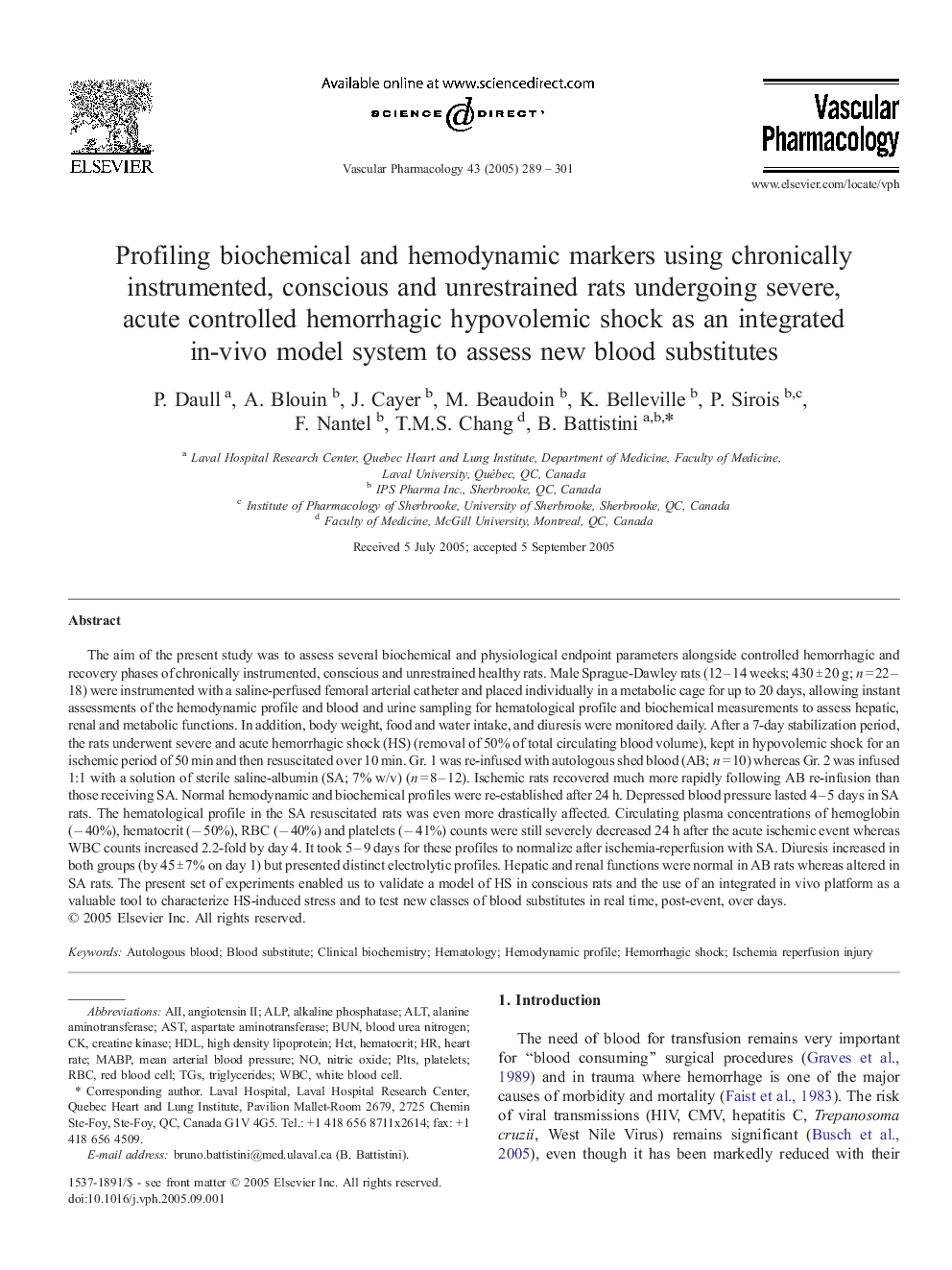| کد مقاله | کد نشریه | سال انتشار | مقاله انگلیسی | نسخه تمام متن |
|---|---|---|---|---|
| 9020855 | 1129731 | 2005 | 13 صفحه PDF | دانلود رایگان |
عنوان انگلیسی مقاله ISI
Profiling biochemical and hemodynamic markers using chronically instrumented, conscious and unrestrained rats undergoing severe, acute controlled hemorrhagic hypovolemic shock as an integrated in-vivo model system to assess new blood substitutes
دانلود مقاله + سفارش ترجمه
دانلود مقاله ISI انگلیسی
رایگان برای ایرانیان
کلمات کلیدی
PLTsHemodynamic profileHDLMABPAIIWBCALTHCTRBCTGs - TG هاAST - آسپارتات ترانس آمینازAspartate aminotransferase - آسپارتات ترانس آمیناز یا AST Ischemia reperfusion injury - آسیب مجدد ایسکمیAlanine aminotransferase - آلانین آمینوترانسفرازALP - آلکالن فسفاتازAlkaline phosphatase - آلکالین فسفاتاز یا فسفاتاز قلیاییAngiotensin II - آنژیوتانسین دوClinical biochemistry - بیوشیمی بالینیTriglycerides - تریگلیسریدBlood substitute - جایگزین خونBUN - خوبAutologous blood - خون اتولوگHemorrhagic shock - شوک هموراژیکHeart rate - ضربان قلبmean arterial blood pressure - فشار خون شریانیhigh density lipoprotein - لیپوپروتئین با چگالی بالاblood urea nitrogen - نیتروژن اوره خونNitric oxide - نیتریک اکسیدHematology - هماتولوژی، خون شناسیhematocrit - هماتوکریتPlatelets - پلاکت هاCreatine kinase - کراتین کینازwhite blood cell - گلبول سفید خونred blood cell - گلبول قرمز، اریتروسیت
موضوعات مرتبط
علوم پزشکی و سلامت
پزشکی و دندانپزشکی
کاردیولوژی و پزشکی قلب و عروق
پیش نمایش صفحه اول مقاله

چکیده انگلیسی
The aim of the present study was to assess several biochemical and physiological endpoint parameters alongside controlled hemorrhagic and recovery phases of chronically instrumented, conscious and unrestrained healthy rats. Male Sprague-Dawley rats (12-14 weeks; 430 ± 20 g; n = 22-18) were instrumented with a saline-perfused femoral arterial catheter and placed individually in a metabolic cage for up to 20 days, allowing instant assessments of the hemodynamic profile and blood and urine sampling for hematological profile and biochemical measurements to assess hepatic, renal and metabolic functions. In addition, body weight, food and water intake, and diuresis were monitored daily. After a 7-day stabilization period, the rats underwent severe and acute hemorrhagic shock (HS) (removal of 50% of total circulating blood volume), kept in hypovolemic shock for an ischemic period of 50 min and then resuscitated over 10 min. Gr. 1 was re-infused with autologous shed blood (AB; n = 10) whereas Gr. 2 was infused 1:1 with a solution of sterile saline-albumin (SA; 7% w/v) (n = 8-12). Ischemic rats recovered much more rapidly following AB re-infusion than those receiving SA. Normal hemodynamic and biochemical profiles were re-established after 24 h. Depressed blood pressure lasted 4-5 days in SA rats. The hematological profile in the SA resuscitated rats was even more drastically affected. Circulating plasma concentrations of hemoglobin (â 40%), hematocrit (â 50%), RBC (â 40%) and platelets (â 41%) counts were still severely decreased 24 h after the acute ischemic event whereas WBC counts increased 2.2-fold by day 4. It took 5-9 days for these profiles to normalize after ischemia-reperfusion with SA. Diuresis increased in both groups (by 45 ± 7% on day 1) but presented distinct electrolytic profiles. Hepatic and renal functions were normal in AB rats whereas altered in SA rats. The present set of experiments enabled us to validate a model of HS in conscious rats and the use of an integrated in vivo platform as a valuable tool to characterize HS-induced stress and to test new classes of blood substitutes in real time, post-event, over days.
ناشر
Database: Elsevier - ScienceDirect (ساینس دایرکت)
Journal: Vascular Pharmacology - Volume 43, Issue 4, October 2005, Pages 289-301
Journal: Vascular Pharmacology - Volume 43, Issue 4, October 2005, Pages 289-301
نویسندگان
P. Daull, A. Blouin, J. Cayer, M. Beaudoin, K. Belleville, P. Sirois, F. Nantel, T.M.S. Chang, B. Battistini,